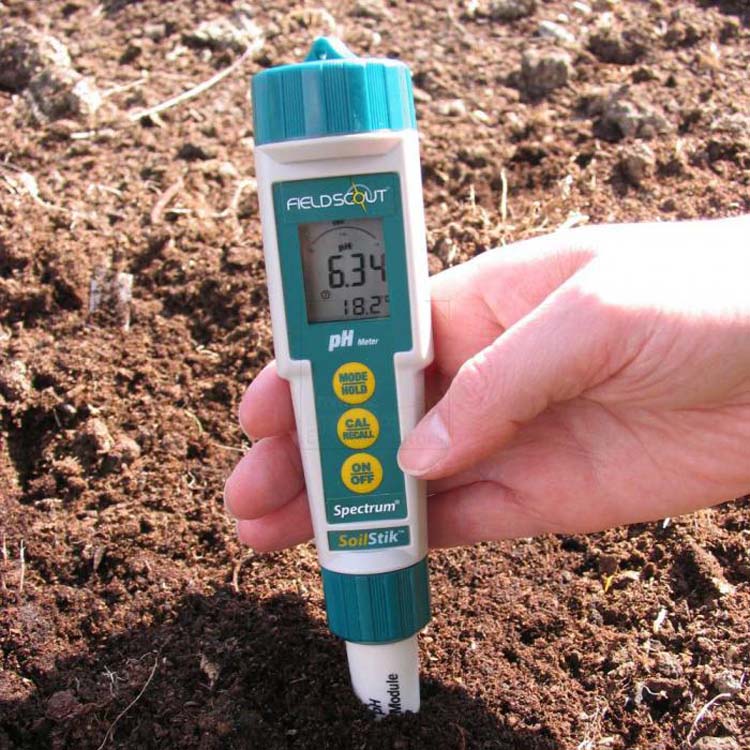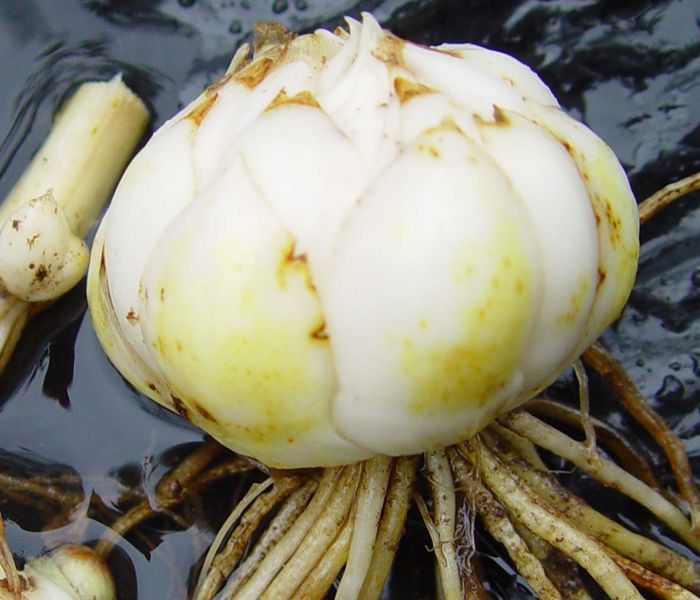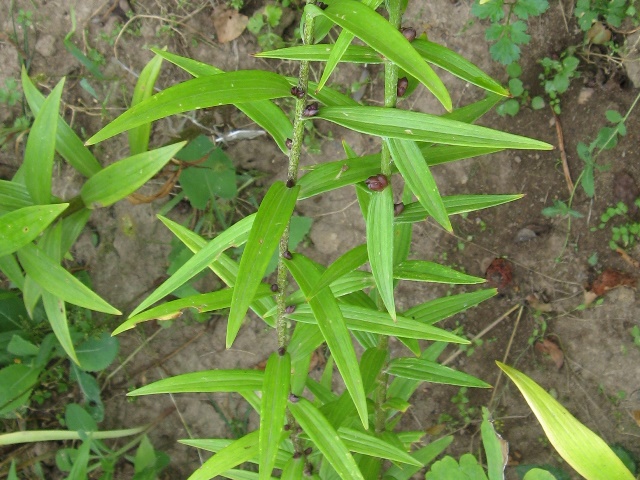Content:
Among the wide variety of perennial flowers, a special place is given to lilies. They are very popular with seasoned florists and novice amateurs. They impress with their stunning beauty. There are many varieties of lilies, choose what you want. But in order to grow excellent healthy flowers at their summer cottage, you need to read the basic recommendations and study the advice of experienced ones.
Planting lilies in the fall: when and how to plant in open ground
This culture loves warmth. It is planted in April, after the snow melts, or in autumn. In dry weather, plants need watering. They need to be covered for the winter.
The best planting dates are from early September to early October. Then the bulbous specimens will get stronger and beautiful flowers will sprout in the spring.
Planting lilies in the fall: when and how to plant
Planting plants in the autumn is not only possible, but even necessary. At this time, the bulbs are at rest, the danger of causing harm to them is minimized. The material planted before winter will bloom early, the plant will have a high resistance to spring frosts. In addition, over the winter, the bushes will have time to take root in a new area and take root.
Before you start planting lilies, you need to take into account the climatic features of the region. The planting period also depends on the variety. For example, Candium, Asian hybrids, oriental varieties are planted in Moscow and the Urals in late summer, and in Siberia in mid-August.
When lilies are planted in the ground in autumn, experienced flower growers:
- from mid-September to the end of October in the areas of the Middle Strip;
- from early September to October in the Urals;
- all September in Siberia;
- from early September to mid-November in Ukraine and southern Russia.
In warm regions, lilies can be planted in October and until mid-November, when autumn is not cold.
If it is not possible to plant the lilies within these periods, the bulbs can be saved until next year by insulating them with dry oak leaves. And if the florist is late with the planting, you can put a wooden box on top of the planting and cover it with waterproof material. This creates a small space for air circulation so that the bulbs do not get blocked during winter.
When can lilies be planted outdoors in short autumn? In this case, it is better to plant the bulbs in November. For autumn sowing, "dormant material" is suitable, that is, the one that has faded and dug out this year.
Preparing for planting sites and bulbs
Particular attention should be paid to the air temperature. If lilies are planted in very warm weather, they can germinate. This should not be allowed, otherwise there will be no positive result. Landing is carried out at temperatures up to 10 ° C.
Soil selection
It is better to plant bulbs in a well-lit area that is protected from the wind.The soil is chosen loamy, sandy or drained. The plant does not like heavy, dense, clayey territories. Do not plant where groundwater is close. The roots can rot and the plant will die.
Soil acidity is also important for lilies. Tubular hybrids, Candidum take root better on neutral or slightly alkaline soil. For other varieties, planting on loam is preferable.
The soil will need to be loosened for better oxygen access and water delivery to the roots. The earth is dug to a depth of 40 cm. In the process, 100 g of superphosphate and 50 g of potassium sulfate are added per 1 m². The culture has a positive attitude to the introduction of peat, compost (5 liters per 1 m²). If the soil is light, only the first component will be sufficient.
Planting material processing
It is important to choose the right bulbs. The germination and development of the lily depends on them. The planting material must be healthy, free from defects, damage, rot. It is preferable to choose bulbs that are large, firm, without softness. Medium sized onions will sprout well, but may not flower until after a year. Small ones will definitely not give flowers in the first year of planting.
Tips for preparing your own bulbous material:
- you need to cut the stems slowly, leaving 5-10 cm from the ground;
- the plants are dug up with a pitchfork, so the root system will remain intact;
- lilies shake off the soil, get rid of dried foliage, herbs, cut off the roots;
- it is possible to disinfect the bulbs with the help of a weak solution of potassium permanganate or means of foundation, benomil. Processing should last at least 30 minutes;
- then the planting material is dried in the shade for a day. This cannot be done in the sun, since the onions will dry out completely.
How to plant lilies with bulbs and bulbs in the fall
In order for the lily to take root better, you need to know how to properly plant in the autumn.
Sequencing:
- form holes for planting;
- put a drainage layer on the bottom;
- make a small hill of sand and plant a copy;
- cover it with fertile soil;
- pour over boiled water;
- insulate with compost, peat, sawdust.
The last manipulations will help keep water in the soil longer and protect the horse system from frost.
Bookmark depth
For a good wintering, planting material must be immersed to the desired depth. It is related to the lily variety:
- Large bulbs of tall plants are immersed 15-20 cm deep, small ones 12 cm long. The length between plantings is from 25 to 30 cm.
- Large medium-sized bulbs of lilies are placed in the soil 12-15 cm, small ones - 10 cm.The distance is maintained at 20-25 cm.
- Low-growing lilies are laid to a depth of 10-12 cm large material, 7 cm - small. The distance between the plantings is 15-20 cm.
Instances can be placed in the wells or laid out on the prepared groove. To do this, make a layer of sand 2-3 cm to protect the material from decay.
Planting sprouts
Flowers with sprouts can be planted when they reach a height of 20 cm. In a circular motion, gently remove the shoots from the bulb. It's great when the whole sprout comes out. Seating is carried out in the usual way. The only thing is that you need to build a comfortable shelter for them. It is impossible to delay planting, it is better to hold events 2 weeks before October.
If the sprouts are longer than 20 cm, you should not dig them out, since such a planting will not bring any result.You can only plant them in a tall pot and grow them at home. Correct planting, attention, feeding with nutrients, watering will help to get healthy lilies. Transplanting into open ground is carried out at the end of May.
Propagation by bulbs
Lilies are propagated not only by bulbs and sprouts, but also by seeds. These bulbs are formed in the leaves of plants. When they crumble to the ground, they begin to sprout, turning into full-fledged adult flowers. But not all varieties produce seeds. To this are located the tiger lily, Asian hybrids, some tubular. After bulb germination, the plant will bloom for only 3 years.
Self-planting bulbs makes sense only in the autumn season. In the ground for some time they increase, in the spring they begin to germinate.
How to plant lilies in the fall
Despite the fact that this perennial plant can easily grow in one area for 4 years, after a while many varieties have children. Their number increases from year to year, and the flowering of the mother sprout decreases. Therefore, they need to be separated.
The vast majority of Asian hybrid lilies produce such an impressive number of babies that some growers recommend replanting them every year. The rest of the perennial varieties form little shoots. This refers to oriental varieties and tubular. Some varieties do not give children at all. In the conditions of the Middle Lane, this is understandable. They lack summer warmth, sun rays.
Further care
No special care is required after sowing lilies. Everything is extremely simple. Watering is carried out if the autumn is dry. The pests are not yet infect, since the shoots have not yet appeared. No processing is carried out. It is transferred to the spring season. You can water through plastic bottles.
Before the onset of stable frosts, the soil is insulated with needles, dry leaves, branches. In addition, mulching will protect future sprouts from snails and slugs. These measures are taken if a frosty winter with little snow is expected. If the weather is moderate, it is not worth covering additionally. Enough 10 cm of snow cover to protect from freezing temperatures.
Correct planting technology, good flower care will preserve the bulbs and help their further growth in the spring. Growing lilies and caring for the bushes is not so difficult, the main thing is to take into account all the nuances described above.



















I live in the northern region of the country, so I start planting lilies in early September so that they have time to take root, and before the onset of cold weather, I warm the planting site well with peat and hay. The depth of setting the bulbs is about 10 cm, and for planting material I take a medium-sized head.
Thank you for the helpful advice for a novice gardener. Last fall, I first planted bulbous plants in the garden, and in the spring I was in for a big disappointment: all the flowers were eaten by mice. I wonder if there is at least one really effective way to protect against them?
This fall, I planted lilies on the site. This beautiful plant grows in the mountains where there is no permanent source of water. Therefore, it does not require regular watering. Ideal, since I do not visit the dacha often. I bought last year's bulbs with sprouts.I did everything as they wrote, only cut off the sprouts so that the flower does not waste energy on them in the cold season.
I am a beginner florist, and I don’t know many subtleties yet. I love lilies very much, and have long dreamed of planting more of them at the dacha in order to admire the beauty and inhale a wonderful aroma. But last autumn I planted them in the second half of October. As a result: all the bulbs have gone bad. I was very upset. Now I figured out all the intricacies of planting and caring for your favorite flowers. The article is a treasure trove of useful information for me. I look forward to seeing my lilies bloom next year. Now I am sure that I did everything right.
Autumn came and I was thinking about planting lilies in my garden. But I had no information in this direction. Having familiarized myself with your site, I received tremendous knowledge and advice in this matter. Now, if such problems arise, I will refer to your materials.
I love these delicate flowers so much and I have a lot of them growing on my site, but, unfortunately, how quickly they fade from me, and some of them look painful. It turns out that I did not take care of them properly, and I planted them with violations. Very useful information, but it's a pity that I got to your site late. I will take into account all the recommendations next season.
Last year I tried to plant lilies on my site, but they somehow did not take root. I was upset and thought that, apparently, not destiny. But it turned out that I just looked after them incorrectly! I'll try again this year, thanks for the article!
I love lilies, I can no longer imagine my summer cottage without these flowers. I planted seven varieties, but unfortunately not all plants have taken root. Good recommendations with the selection of soil, henceforth I will take into account the characteristics of each variety.